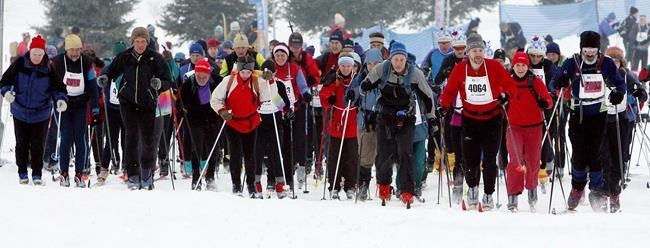One of Canada's most storied nordic ski events is shifting farther north as climate change is causing less snow on low-lying portions of its route.
Dan Quinlan, the president of the Canadian Ski Marathon, said the board recently approved the northern route for the first half of the winding, hilly 160-kilometre trek north of the Ottawa River in southwestern Quebec.
Cross-country skiers who for 51 years have slid over roughly 80 kilometres of trails between Buckingham and Montebello, will instead ski the same distance along a more wooded, higher route just south of Mont Tremblant to Montebello this winter.
"We want to make sure we can keep going for many years to come, and going north helps that," Quinlan said in a recent interview.
"A lot of the western trail is in fields, rather than in the woods, and when we have a small or not so good snow coverage, we have difficulty in those areas."
The 57-year-old volunteer said the decision was based both on climate change and increasing difficulties obtaining the right to cross private properties as population density increased.
The Canadian Ski Marathon — the longest in North America — is attended by several thousand skiers who use classic, striding technique over its rolling hills, frozen lakes, and an infamous "bobsled run" that even experts descend with care.
Hundreds of volunteers provide support along the way, shovelling snow onto crossings and road portions of the route, shouting encouragement and providing warm drinks and snacks to the often-exhausted participants.
Skiers range from people out to enjoy a short portion of the course up to "coureurs de bois" who carry packs with overnight gear, eat around blazing campfires and sleep under the stars.
In the early hours of the morning, hundreds of headlamps weave across rolling fields as the skiers set off in an event created as a celebration of the Canadian winter and closely associated with pioneer cross-country skier Herman Smith-Johannsen.
Ross Brown, a climate scientist with Environment Canada, said in an interview Wednesday it's wise to make adaptations to climate change, adding the process is already underway for commercial alpine ski operators in the region who must make snow.
"For southern Canadians, the natural snow cover has become one of the most sensitive things for global warming, and I think it's become one of the things people take for granted," he said from Montreal.
The scientist said southwestern Quebec is among the Canadian regions that is seeing a shorter snowfall season and lower overall accumulations of snow.
"The maximum accumulation of snow is going down ... the warmer regions of Canada's climates are responding the fastest," he said.
Brown said moving the event to a more forested, higher elevation area makes sense because those areas tend to have lower temperatures and more shade, while in open areas wind blows snow away.
The climate scientist ran a check on snowfalls in southwestern Quebec from 1965 until 2013 and found a "statistically significant decline" in mid-February levels "of close to one centimetre per year."
Snow depths averaged close to 60 centimetres in the first decade of the marathon, but only averaged 27 centimetres for the most recent decade.
Brown said the projections for future snow accumulations vary but one scenario with "business as usual" levels of global carbon emissions show average reductions of 30 to 45 per cent in maximum snow accumulation in the region by 2050 compared to 1970-1999.
The new route will involve the crossing of frozen waterways, but Quinlan said organizers have worked out alternative routes around the crossings if thinner ice becomes a feature of climate change.
Elsewhere in Canada, low snowfalls have also had an impact on skiing.
Last year, a World Cup downhill at Lake Louise, Alta., was cancelled in November due to higher temperatures than usual.
For skiers, global warming means a shift in the traditional locations of the sport, said Brown.
"Moving north, or to higher elevations, is a logical adaptation to reduce the impact of projected warming on snow cover," he wrote in an email.
———
Follow @mtuttoncporg on Twitter
Michael Tutton, The Canadian Press

